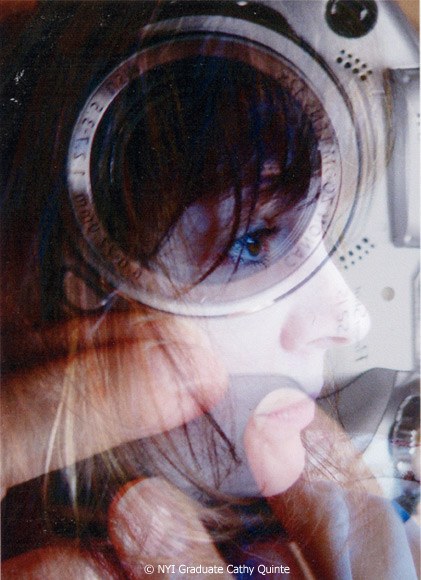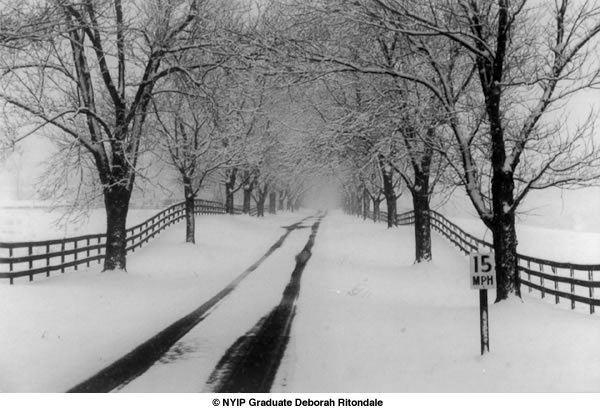We at NYIP Photography School decided to harness that power to drive Photographer's Spotlight.
Editor's Note: One of the great benefits of the Internet is that there is a tremendous amount of information about photographers now available on line. From Ansel Adams to Monte Zucker, from the nineteenth century pioneers to today's cutting-edge photographers, you can find an ever-growing body of information about photographers on the Internet, along with examples of their work. While the Web is a powerful new research tool, not all information is necessarily accurate.
We've decided to harness that power to drive Photographer's Spotlight. Each month, we'll run a brief biography of a photographer that we consider important enough so that everyone interested in photography should be familiar with that person's work. In addition to printed resources, we'll give you the URL addresses of some of the best sites we've found that showcase the life and work of the photographer that is featured this month. We'll also note books about the photographer or books that show the photographer's work. If you would like to suggest photographers you feel we should cover, e-mail us with their names. This month we feature one of our most popular Photographer's Spotlight columns on Nicholas Nixon.
Among Nicholas Nixon's best known photo series are The Brown Sisters, People with Aids, School, and Pictures of People — series which show us again and again why his work with the slow, contemplative large format camera surprises and enthralls viewers. It is because the results are more than portraiture; large format has never been used in quite the way Nixon uses it. Technically, his photos are always thrillingly composed and lovingly detailed. Emotionally, his photos inhabit a world somewhere between the action click and the thoughtful composition, capturing fleeting but meaningful moments. His subjects' expressions combine a buoyant hopefulness with an ominous cognizance of human frailty. These qualities are what give his photographs their poignancy.
The Brown Sisters
Those who know Nicholas Nixon likely know him through The Brown Sisters, an ongoing project dedicated to annual photos Nixon has taken of his wife and her three sisters for the past twenty-five years. According to Peter Galassi, Chief Photography Curator at the Museum of Modern Art, "the series is utterly simple and familiar, like a family album . . . ." ¹ It testifies to the photographer's affection, empathy, artistry and honesty — and succeeds as more than good photography. His works challenge viewers to acknowledge the changes wrought by aging and to find cheer in the warmth of human connection. And though family is the subject of his photography, Nixon never descends into a declaration of "family values." Instead, he celebrates lasting familial ties; his works confirm love's transcendence over ordinariness and mortality. Looking at the four women, always posed in the same order, is a window into the past quarter century.
People With Aids
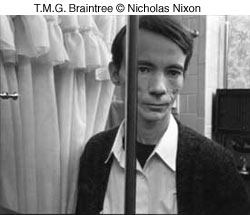
Photographs from the People with Aids project, once hugely controversial, illustrate similar qualities. A 1987 picture of Thomas Moran, an AIDS sufferer, evokes the stark honesty of the series. In the photo, Moran is shown, his back to the camera, bare-torsoed, his spinal column clearly visible through paper-thin skin. He reaches out to touch a sunlit window as if to touch the sunlight itself. Another picture finds Moran facing the camera, bearing a frank if resigned expression. The picture is halved by a metal pole, as if to conjure Moran's predicament — living, but living with a deadly disease. ²
A New York University literary review of People with Aids (the resulting book), sums up the series: "Once decried as another victimization of the person with AIDS, Nixon's photographs are now being reconsidered as historically important and aesthetically significant, as highly exceptional counterpoints to the by now entrenched iconography or the healthy and beautiful person with HIV/AIDS."³
School
Nixon's School photography has been described alternately as a "subtle profound indictment of schools" 4 and as a paean to the devotion of teachers, the importance of affirmative action, and the enthusiasm and achievements of the kids themselves.5
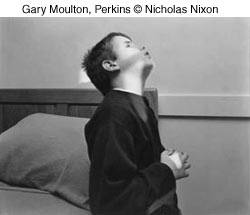
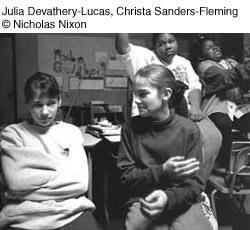
In one photo, from Perkins School for the Blind, a boy sits on the end of his bed, his hands clasped prayerfully, his head raised as if he is searching for the unseeable. In another photo from the Tobin School, Room 306, the classroom has erupted into only slightly controlled mayhem. One girl sits on the edge of a desk, eyes closed, seemingly dancing to her own music. Her neighbor, also seated on the edge of a desk, has her hand raised to answer a question. In the foreground a girl looks questioningly to her classmate. Her classmate sits, arms crossed, in a sulk.
School, as a whole, pays homage to the difficulty of teaching in the strangely antiseptic environments in which our society places both students and teachers. Once again, Nixon captures the complexity of a difficult situation. As Galassi puts it, "His pictures persuade us that we see individuals, not symptoms of a problem, or worse, heroes of a solution." 6
Pictures of People
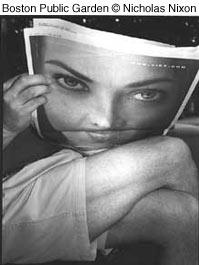
His newest photographs are different, but still photographs of relationships both physical and emotional. In Pictures of People, Nixon tends to omit faces, opting instead for views of torsos, arms, hands, legs, and/or feet. His abstract forms read like poetry, yet remain amazingly unselfconscious of themselves as "Art."
Nixon never leaves the viewer with a sense that his subjects are dissected. While Nixon simplifies the human body into abstract forms, he maintains his subjects' humanity; his works always acknowledge the limitations set by our mortality — and the necessity of connecting emotionally even in the face of it. Where action photographers seek decisive moments, Nixon seeks decisive interactions.
The last three works, recently created, are devoted to relationships between men and women. In the first, we are shown the torso of a thirtyish male seated on a park bench, legs crossed; the oversized face of a beautiful woman peers out from the back page of his open newspaper. In another photo, we see the torso of a young teenage girl wearing a black-and-white striped shirt. Her arms are goose-pimpled from the cold. Her teenage boyfriend is barely visible in the picture. His awkward one finger grasp is our only evidence of his presence. The last shows the vulnerable open back of a woman. All we see of her male partner is his embracing arms.
All three testify to a recurring theme in Nixon's work — that physical relationships (almost physical entanglements) mirror emotional ones. They also show men being tender, and women showing the vulnerability to need men's tenderness. That men are almost omitted while women loom large is telling; Nixon's photography has always displayed a marked empathy for women and a need to show them as important. Finally, each picture makes reference to a universal need-the need for companionship.

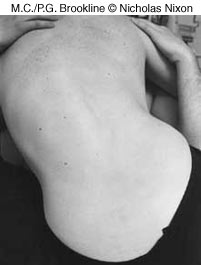
Last Thoughts
As Galassi asserts, Nixon's work "embraces the idea that sympathetic photographs of ordinary... people can address the deepest human values." 7 It is this capacity that gives Nixon's works nobility-and a place in the top photography of his era.
Resources
- Nicholas Nixon, Pictures of People, Museum of Modern Art, 1988 (introduction by Peter Galassi)
- People with Aids, Museum of Modern Art, 1988
- Nixon, Nicholas/ People with Aids, New York University's online book reviews for Literature Arts and Medicine
- "Still Stories: Nicholas Nixon's 'school art,'" The Boston Phoenix, Nov.26 - Dec 3, 1998
- "Race to the Top," Mother Jones, Sept/October 1997 (By Bebe Nixon)
- Nicholas Nixon, Pictures of People, Museum of Modern Art, 1988 (introduction by Peter Galassi)
- Nicholas Nixon, Pictures of People, Museum of Modern Art, 1988 (introduction by Peter Galassi)


